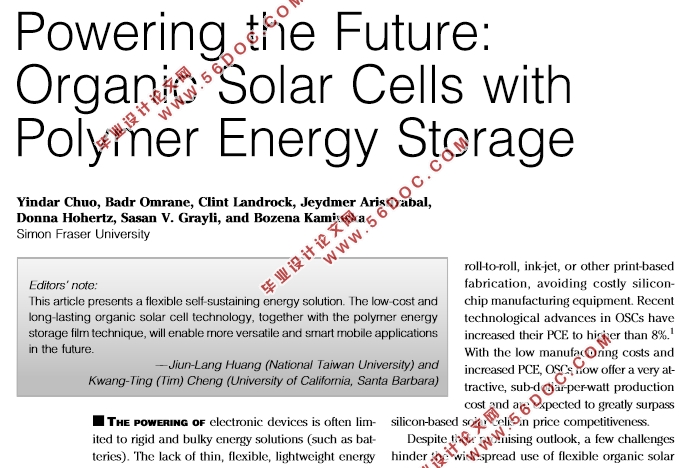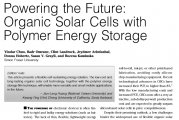驱动未来:有机太阳能电池的聚合物储能(中文6000字,英文4000字,英文PDF)
Yindar Chuo, Badr Omrane, Clint Landrock, Jeydmer Aristizabal, Donna Hohertz, Sasan V. Grayli, and Bozena Kaminska
电子设备的供电,往往是由有限的坚硬和庞大的能源解决的(如电池)。薄,柔韧,质轻的能源缺乏,限制了应用领域的创新,如无线,自主,灵活的系统。少数的“软”(聚合物)电池是新的市场,但是,他们的容量小并且经常需要维修。虽然能量的收集有提供补充的前提,或者,在某些情况下,提供独立的连续功率,在本质上需要某些功能和环境的匹配。一些轻量,小型化的能量收集解决方案已经被证明(如微振动能量采集),但大多数都适用于某些特定的应用程序,复杂的,昂贵的制造,最终还是坚硬的。
Powering the Future: Organic Solar Cells with Polymer Energy Storage
The powering of electronic devices is often limited to rigid and bulky energy solutions (such as batteries). The lack of thin, flexible, lightweight energy sources restricts innovations in application areas such as wireless, autonomous, and flexible systems. A small number of ‘‘soft’’ (polymer) batteries are newly available on the market; however, their small capacity implies frequent servicing. Although energy harvesting has the potential to provide supplementary or, in some cases, stand-alone continuous power, it inherently requires the matching of function and environment. Several lightweight, miniaturized energy-harvesting solutions have been demonstrated (such as microvibration energy harvesting), but most are extremely application specific, complex, expensive to manufacture, and ultimately still rigid.

|



